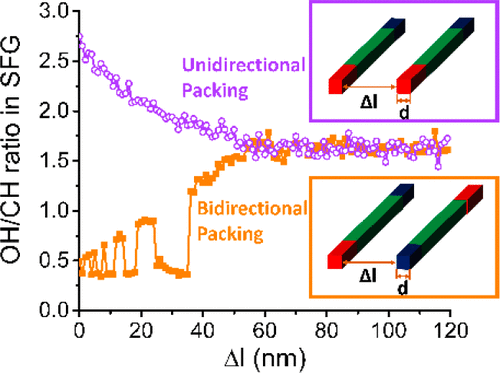当前位置:
X-MOL 学术
›
J. Phys. Chem. B
›
论文详情
Our official English website, www.x-mol.net, welcomes your feedback! (Note: you will need to create a separate account there.)
Distinguishing Mesoscale Polar Order (Unidirectional vs Bidirectional) of Cellulose Microfibrils in Plant Cell Walls Using Sum Frequency Generation Spectroscopy.
The Journal of Physical Chemistry B ( IF 3.3 ) Pub Date : 2020-08-17 , DOI: 10.1021/acs.jpcb.0c07076 Mohamadamin Makarem 1 , Yoshiharu Nishiyama 2 , Xiaoran Xin 3 , Daniel M Durachko 4 , Ying Gu 3 , Daniel J Cosgrove 4 , Seong H Kim 1
The Journal of Physical Chemistry B ( IF 3.3 ) Pub Date : 2020-08-17 , DOI: 10.1021/acs.jpcb.0c07076 Mohamadamin Makarem 1 , Yoshiharu Nishiyama 2 , Xiaoran Xin 3 , Daniel M Durachko 4 , Ying Gu 3 , Daniel J Cosgrove 4 , Seong H Kim 1
Affiliation

|
Cellulose in plant cell walls are synthesized as crystalline microfibrils with diameters of 3–4 nm and lengths of around 1–10 μm. These microfibrils are known to be the backbone of cell walls, and their multiscale three-dimensional organization plays a critical role in cell wall functions including plant growth and recalcitrance to degradation. The mesoscale organization of microfibrils over a 1–100 nm range in cell walls is challenging to resolve because most characterization techniques investigating this length scale suffer from low spatial resolution, sample preparation artifacts, or inaccessibility of specific cell types. Here, we report a sum frequency generation (SFG) study determining the mesoscale polarity of cellulose microfibrils in intact plant cell walls. SFG is a nonlinear optical spectroscopy technique sensitive to the molecular-to-mesoscale order of noncentrosymmetric domains in amorphous matrices. However, the quantitative theoretical model to unravel the effect of polarity in packing of noncentrosymmetric domains on SFG spectral features has remained unresolved. In this work, we show how the phase synchronization principle of the SFG process is used to predict the relative intensities of vibrational modes with different polar angles from the noncentrosymmetric domain axis. Applying this model calculation for the first time and employing SFG microscopy, we found that cellulose microfibrils in certain xylem cell walls are deposited unidirectionally (or biased in one direction) instead of the bidirectional polarity which was believed to be dominant in plant cell walls from volume-averaged characterizations of macroscopic samples. With this advancement in SFG analysis, one can now determine the relative polarity of noncentrosymmetric domains such as crystalline biopolymers interspersed in amorphous polymer matrices, which will open opportunities to study new questions that have not been conceived in the past.
中文翻译:

使用求和频率生成光谱法区分植物细胞壁中纤维素微纤维的中尺度极性顺序(单向和双向)。
植物细胞壁中的纤维素被合成为直径为3–4 nm且长度约为1–10μm的结晶微纤维。这些微纤维是细胞壁的骨干,它们的多维三维组织在细胞壁功能(包括植物生长和对降解的抵抗)中起着关键作用。在细胞壁中1-100 nm范围内的微纤维中尺度组织很难解决,因为研究这种长度尺度的大多数表征技术都存在空间分辨率低,样品制备伪影或特定细胞类型难以接近的问题。在这里,我们报告总频率生成(SFG)研究,确定完整植物细胞壁中纤维素微纤维的介观极性。SFG是一种非线性光学光谱技术,对非晶基质中非中心对称结构域的分子到中尺度级敏感。但是,定量理论模型来解开非中心对称域的堆积对SFG光谱特征的影响的极性仍未解决。在这项工作中,我们展示了SFG过程的相位同步原理如何用于从非中心对称域轴预测具有不同极角的振动模式的相对强度。首次应用此模型计算并使用SFG显微镜,我们发现,某些木质部细胞壁中的纤维素微纤维是单向沉积的(或偏向一个方向),而不是由宏观样品的体积平均表征所认为在植物细胞壁中占主导地位的双向极性。借助SFG分析的这一进步,现在可以确定非中心对称结构域的相对极性,例如散布在非晶态聚合物基质中的晶体生物聚合物,这将为研究过去未曾想到的新问题提供机会。
更新日期:2020-09-18
中文翻译:

使用求和频率生成光谱法区分植物细胞壁中纤维素微纤维的中尺度极性顺序(单向和双向)。
植物细胞壁中的纤维素被合成为直径为3–4 nm且长度约为1–10μm的结晶微纤维。这些微纤维是细胞壁的骨干,它们的多维三维组织在细胞壁功能(包括植物生长和对降解的抵抗)中起着关键作用。在细胞壁中1-100 nm范围内的微纤维中尺度组织很难解决,因为研究这种长度尺度的大多数表征技术都存在空间分辨率低,样品制备伪影或特定细胞类型难以接近的问题。在这里,我们报告总频率生成(SFG)研究,确定完整植物细胞壁中纤维素微纤维的介观极性。SFG是一种非线性光学光谱技术,对非晶基质中非中心对称结构域的分子到中尺度级敏感。但是,定量理论模型来解开非中心对称域的堆积对SFG光谱特征的影响的极性仍未解决。在这项工作中,我们展示了SFG过程的相位同步原理如何用于从非中心对称域轴预测具有不同极角的振动模式的相对强度。首次应用此模型计算并使用SFG显微镜,我们发现,某些木质部细胞壁中的纤维素微纤维是单向沉积的(或偏向一个方向),而不是由宏观样品的体积平均表征所认为在植物细胞壁中占主导地位的双向极性。借助SFG分析的这一进步,现在可以确定非中心对称结构域的相对极性,例如散布在非晶态聚合物基质中的晶体生物聚合物,这将为研究过去未曾想到的新问题提供机会。



























 京公网安备 11010802027423号
京公网安备 11010802027423号